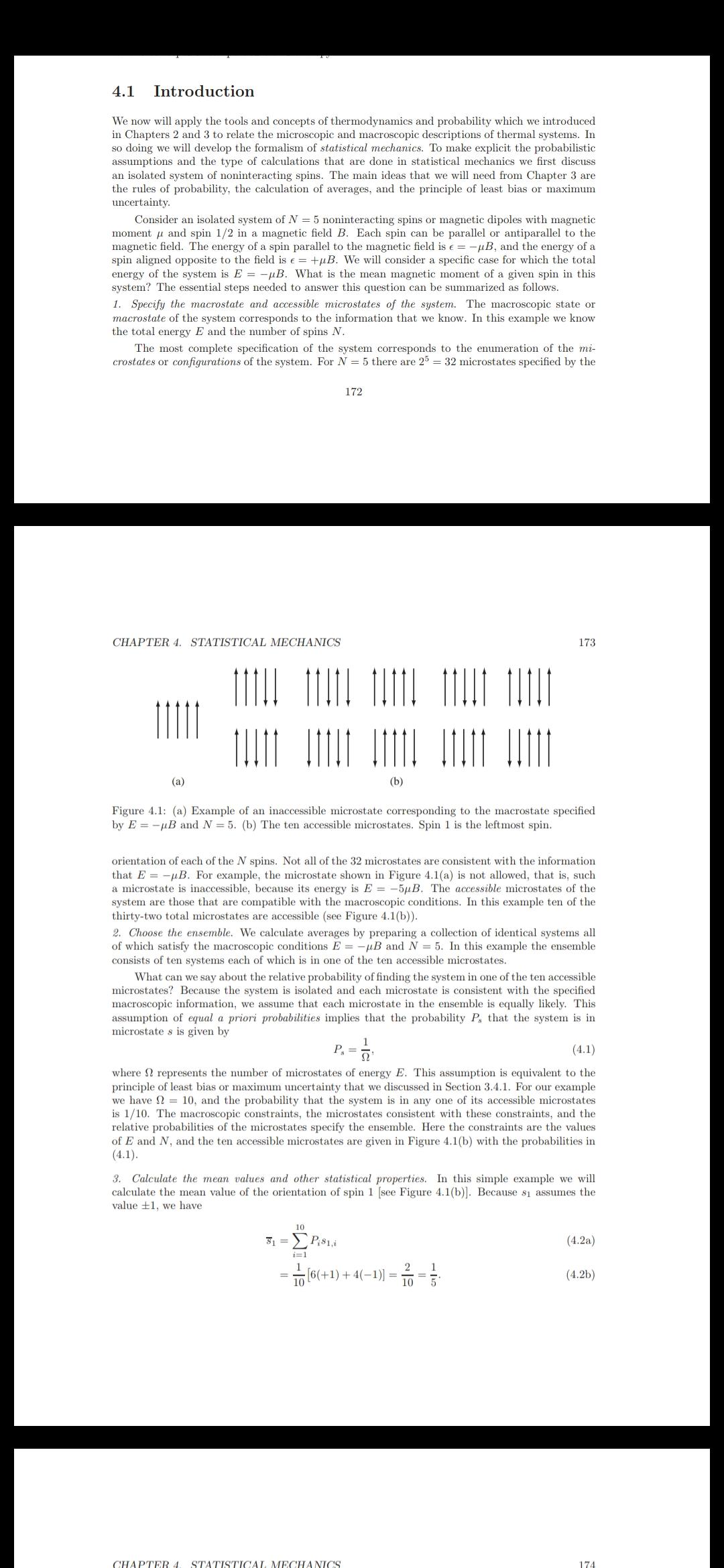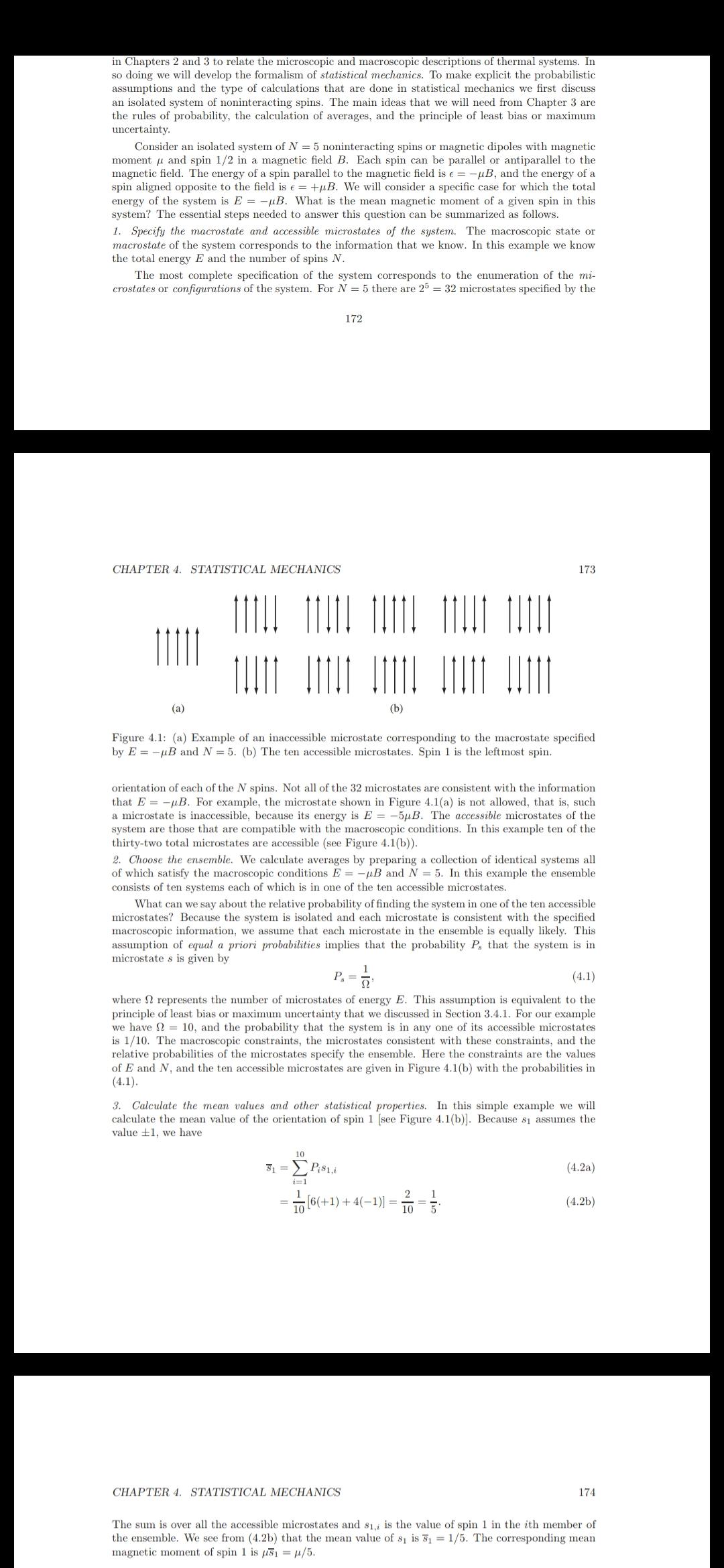Answered step by step
Verified Expert Solution
Question
1 Approved Answer
(a) What is the mean value of spin 2 in the above example? Why is its mean value not zero? (b) What is the



(a) What is the mean value of spin 2 in the above example? Why is its mean value not zero? (b) What is the probability p that a given spin points up? (c) What is the probability that if spin 1 is up, then spin 2 also is up? There is a more direct way of calculating 3 in this case. Because the magnetization of the system is M = , three out of the five spins are up. The equivalency of the spins implies that the probability of a spin being up is 3/5. Hence, 3 (1)(3/5)+(-1) (2/5) = 1/5. What is the implicit assumption that we made in the more direct method? 4.1 We now will apply the tools and concepts of thermodynamics and probability which we introduced in Chapters 2 and 3 to relate the microscopic and macroscopic descriptions of thermal systems. In so doing we will develop the formalism of statistical mechanics. To make explicit the probabilistic assumptions and the type of calculations that are done in statistical mechanics we first discuss an isolated system of noninteracting spins. The main ideas that we will need from Chapter 3 are the rules of probability, the calculation of averages, and the principle of least bias or maximum uncertainty. Introduction Consider an isolated system of N = 5 noninteracting spins or magnetic dipoles with magnetic moment and spin 1/2 in a magnetic field B. Each spin can be parallel or antiparallel to the magnetic field. The energy of a spin parallel to the magnetic field is =-uB, and the energy of a spin aligned opposite to the field is = +B. We will consider a specific case for which the total energy of the system is E-B. What is the mean magnetic moment of a given spin in this system? The essential steps needed to answer this question can be summarized as follows. 1. Specify the macrostate and accessible microstates of the system. The macroscopic state or macrostate of the system corresponds to the information that we know. In this example we know the total energy E and the number of spins N. The most complete specification of the system corresponds to the enumeration of the mi- crostates or configurations of the system. For N = 5 there are 25 = 32 microstates specified by the CHAPTER 4. STATISTICAL MECHANICS (a) LL L L 1 10011 172 Figure 4.1: (a) Example of an inaccessible microstate corresponding to the macrostate specified by E-B and N = 5. (b) The ten accessible microstates. Spin 1 is the leftmost spin. orientation of each of the N spins. Not all of the 32 microstates are consistent with the information that E-B. For example, the microstate shown in Figure 4.1(a) is not allowed, that is, such a microstate is inaccessible, because its energy is E= -5B. The accessible microstates of the system are those that are compatible with the macroscopic conditions. In this example ten of the thirty-two total microstates are accessible (see Figure 4.1(b)). 2. Choose the ensemble. We calculate averages by preparing a collection of identical systems all of which satisfy the macroscopic conditions E= -uB and N = 5. In this example the ensemble consists of ten systems each of which is in one of the ten accessible microstates. What can we say about the relative probability of finding the system in one of the ten accessible microstates? Because the system is isolated and each microstate is consistent with the specified macroscopic information, we assume that each microstate in the ensemble is equally likely. This assumption of equal a priori probabilities implies that the probability P, that the system is in microstate s is given by 10 (b) P = (4.1) where represents the number of microstates of energy E. This assumption is equivalent to the principle of least bias or maximum uncertainty that we discussed in Section 3.4.1. For our example we have 2 = 10, and the probability that the system is in any one of its accessible microstates is 1/10. The macroscopic constraints, the microstates consistent with these constraints, and the relative probabilities of the microstates specify the ensemble. Here the constraints are the values of E and N, and the ten accessible microstates are given in Figure 4.1(b) with the probabilities in (4.1). 31 = Pi81,i i=1 1 10 173 1 3. Calculate the mean values and other statistical properties. In this simple example we will calculate the mean value of the orientation of spin 1 [see Figure 4.1(b)]. Because si assumes the value 1, we have. CHAPTER 4. STATISTICAL MECHANICS [6(+1)+4(-1)] = 2 1 10 5 (4.2a) (4.2b) 174 in Chapters 2 and 3 to relate the microscopic and macroscopic descriptions of thermal systems. In so doing we will develop the formalism of statistical mechanics. To make explicit the probabilistic assumptions and the type of calculations that are done in statistical mechanics we first discuss an isolated system of noninteracting spins. The main ideas that we will need from Chapter 3 are the rules of probability, the calculation of averages, and the principle of least bias or maximum uncertainty. Consider an isolated system of N = 5 noninteracting spins or magnetic dipoles with magnetic moment and spin 1/2 in a magnetic field B. Each spin can be parallel or antiparallel to the magnetic field. The energy of a spin parallel to the magnetic field is =-uB, and the energy of a spin aligned opposite to the field is = +B. We will consider a specific case for which the total energy of the system is E-uB. What is the mean magnetic moment of a given spin in this system? The essential steps needed to answer this question can be summarized as follows. 1. Specify the macrostate and accessible microstates of the system. The macroscopic state or macrostate of the system corresponds to the information that we know. In this example we know the total energy E and the number of spins N. The most complete specification of the system corresponds to the enumeration of the mi- crostates or configurations of the system. For N = 5 there are 25 = 32 microstates specified by the CHAPTER 4. STATISTICAL MECHANICS (a) 111!! 11 172 Figure 4.1: (a) Example of an inaccessible microstate corresponding to the macrostate specified by E-B and N = 5. (b) The ten accessible microstates. Spin 1 is the leftmost spin. (b) orientation of each of the N spins. Not all of the 32 microstates are consistent with the information that E-B. For example, the microstate shown in Figure 4.1(a) is not allowed, that is, such a microstate is inaccessible, because its energy is E= -5B. The accessible microstates of the system are those that are compatible with the macroscopic conditions. In this example ten of the thirty-two total microstates are accessible (see Figure 4.1(b)). 2. Choose the ensemble. We calculate averages by preparing a collection of identical systems all of which satisfy the macroscopic conditions E-B and N = 5. In this example the ensemble consists of ten systems each of which is in one of the ten accessible microstates. What can we say about the relative probability of finding the system in one of the ten accessible microstates? Because the system is isolated and each microstate is consistent with the specified macroscopic information, we assume that each microstate in the ensemble is equally likely. This assumption of equal a priori probabilities implies that the probability Ps that the system is in microstate s is given by 10 3 = P;$1,i 173 P = 1/2 (4.1) where represents the number of microstates of energy E. This assumption is equivalent to the principle of least bias or maximum uncertainty that we discussed in Section 3.4.1. For our example we have = 10, and the probability that the system is in any one of its accessible microstates is 1/10. The macroscopic constraints, the microstates consistent with these constraints, and the relative probabilities of the microstates specify the ensemble. Here the constraints are the values of E and N, and the ten accessible microstates are given in Figure 4.1(b) with the probabilities in (4.1). 10 3. Calculate the mean values and other statistical properties. In this simple example we will calculate the mean value of the orientation of spin 1 [see Figure 4.1(b)]. Because si assumes the value 1, we have CHAPTER 4. STATISTICAL MECHANICS [6(+1) + 4(-1)] = 2 1 10 = 5 (4.2a) (4.2b) 174 The sum is over all the accessible microstates and 81, is the value of spin 1 in the ith member of the ensemble. We see from (4.2b) that the mean value of 8 is 3 = 1/5. The corresponding mean magnetic moment of spin 1 is us1 = /5.
Step by Step Solution
★★★★★
3.48 Rating (161 Votes )
There are 3 Steps involved in it
Step: 1

Get Instant Access to Expert-Tailored Solutions
See step-by-step solutions with expert insights and AI powered tools for academic success
Step: 2

Step: 3

Ace Your Homework with AI
Get the answers you need in no time with our AI-driven, step-by-step assistance
Get Started


